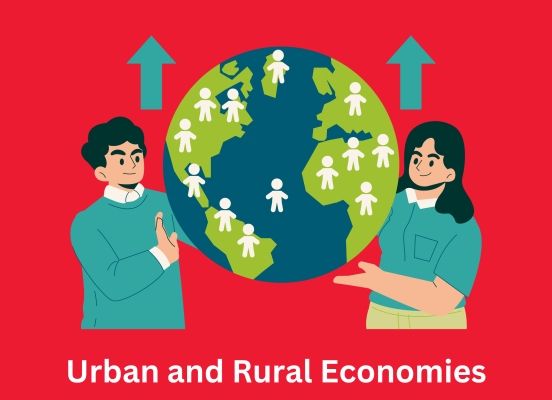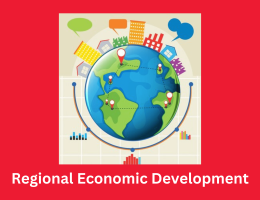
Urban and Rural Economies: Comparing Economic Dynamics, Influencing Factors, and Linkages
- By admin --
- Thursday, 07 Mar, 2024
Introduction:
Different economic environments are determined in city and rural areas, every with its very own dynamics, possibilities, and issues. Examining the variables influencing urbanization, the connections amongst city and rural regions, and the phenomena of city sprawl, this essay gives a comparative have a observe of the monetary dynamics of town and rural economies.
Economic Dynamics of Urban Areas:
Urban economies are defined by dense populations, large economic interests, and large infrastructure. Cities attract people and investment because they become centers of innovation, economic interest and employment opportunities. In addition to the economic empowerment component of cities, it is motivated by a number of:
-
Economic Diversification: A large shape of sectors and industries, inclusive of producing, services, era, finance, and manufacturing, make a contribution to the prosperity of metropolis economies. Diversity promotes resilience, specialization, and innovation, which complements economic growth and competitiveness.
-
Efficiency of the Labor Market: Cities have a large and sundry hard work pool that makes it much much less tough for employers and employees to wholesome. Many agencies and sectors foster possibilities for potential development, expert increase, and entrepreneurship, which increases earnings and productiveness.
-
Infrastructure and Connectivity: Urban regions have strong networks of utilities, transportation, and conversation infrastructure. This infrastructure helps exchange and monetary interest with the beneficial resource of enhancing connection, lowering transaction charges, and facilitating the flow of statistics, commodities, and services.
Economic Dynamics of Rural Areas:
In evaluation, the tendencies of rural economies encompass a lower populace density, a dependence on number one industries like mining, forestry, and agriculture, and restrained get proper of get right of entry to to to town services. Various variables effect the economic dynamics of rural regions, together with:
-
Natural Resource Dependency: The critical assets of income for a huge quantity of rural economies are the extraction of natural property, agriculture, or tourism. Rural livelihoods and economic stability can be notably impacted thru weather patterns, environmental suggestions, and commodity charge volatility.
-
Limited employment opportunities: It may be difficult to create enough jobs in rural areas especially in sectors other than accessible jobs. Lack of access to training, schooling, and specialized supplies can further limit entrepreneurial endeavors and stifle economic diversification.
-
Infrastructure Deficits: Inadequate broadband net connection, healthcare facilities, and transportation networks are some of the infrastructure troubles that rural organizations may also face. Inadequate infrastructure creates gaps amongst rural and urban regions, hinders employer improvement, and makes connecting tough.
Factors Influencing Urbanization:
Numerous factors, which includes the subsequent, have an effect on urbanization, the approach of population awareness and spatial extension of city regions:
-
Economic Opportunities: People migrate to towns attempting to find art work, better dwelling situations, and extra wages. The interest of financial hobby in cities attracts humans from rural regions who are looking for higher methods to live.
-
Urbanization and Industrialization: As cities' manufacturing and company sectors enlarge, humans bypass from rural to urban regions in pursuit of process opportunities. As a result, urbanization and industrialization often take area concurrently.
-
Infrastructure Development: By growing accessibility, cutting down on go backward and forward times, and enhancing dwelling situations in cities, investments in infrastructure—which include housing, utilities, and transportation networks—help to sell town increase.
Urban-Rural Linkages:
Numerous economic, social, and environmental connections exist between urban and rural regions, which encompass:
-
Labor Market Flows: As employment hubs, metropolis regions draw people from rural regions who are looking for work. On the other hand, agricultural items, raw substances, and tough paintings for sure industries are provided with the aid of using rural regions to metropolitan centers.
-
Market Access and Trade: While rural areas deliver urban facilities with requirements like food, water, and strength assets, city areas also offer markets for rural merchandise and agricultural commodities.
-
Knowledge Transfer and Innovation: Connections among city and rural regions promote the alternate of ideas, generation, and know-how. Extension offerings, universities, and studies facilities are essential for bringing fantastic practices and information to rural areas.
Urban Sprawl:
The time period "town sprawl" describes the outward extension of urban improvement into neighboring rural areas, which might be typified with the resource of low land use densities and a dependence on automobiles. Urban sprawl is encouraged by way of the usage of things like:
-
Population Growth: As a end end result of rising land, housing, and infrastructure needs, urban areas' fast populace boom reasons their borders to spread into nearby rural regions.
-
Land Use regulations: The degree and rate of town sprawl may be inspired by way of zoning legal hints, land-use making plans options, and development strategies. By permitting unrestrained increase in peri-city areas, permissive zoning guidelines and loose land-use controls may additionally moreover make contributions to the phenomenon of sprawl.
-
Automobile Dependency: By permitting commuters to are living further from town centers and inspiring dispersed improvement styles, the big use of vehicles due to the fact the primary method of transportation contributes to city sprawl.
Comparing Urban and Rural Economies:
When in comparison to rural economies, city economies show higher levels of financial variety, productiveness, and connection. Cities draw a numerous population and encourage innovation and entrepreneurship due to the fact they offer a wealth of services, offerings, and employment possibilities. On the other hand, the shortage of activity opportunities, insufficient infrastructure, and reliance on number one industries frequently plague rural economies, ensuing in reduced living requirements and income stages for the population.
Conclusion:
Specifically, urban and rural economies are distinctly different economic contexts and different growth, possibilities and information with the help of roads Although cities are engines of economic growth, innovation and connectivity rural areas are important that they provide hard work, assets and needs for urban recovery Resilience of the rural population And red meat requires planners, planners, and stakeholders to have in-depth information about urbanization, urban and rural interactions, and variables of influence Concrete expansion.





